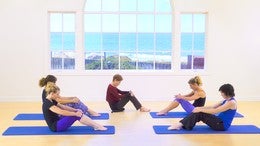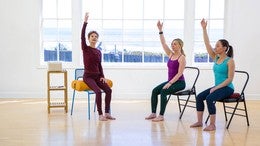Description
About This Video
Transcript
Read Full Transcript
So I had this opportunity to introduce you to this idea of a certain kind of stretching program that I put together. Um, many years ago when I started teaching the postural assessment, I ended up doing workshops, teaching people how to see bodies and see body patterns and I wanted sun exercises throughout the days where change would happen quickly and then they could look at their partner again and see what actually transpired. So they'd look at their partner. We do an exercise such as the stretching exercise or a loosening exercise or a toning exercise and have them look at their partner afterward. Again, I used to do these as partners stretches, but it just became easier if people could do this on their own by themselves. So I took the idea of a pulley on a ski rope, so to speak. This one I think is ski rope material and because it moves so easily, you can work bilaterally to create these stretches for the body. And I'll show you those in just one moment.
So here is a poorly that we made a, this is a strong webbing used as a strap. This is about 35 inches, including the knot, the double knot that's tied here at the end. This can loop over a door handle and come through, um, want to make sure that the door can lock. It's usually best to use this on the side that doesn't open just for safety. So this goes around the door, not, and then you need about 12 feet of rope and you can change all of these measurements for your door or for your height or what have you. And then these are just, um, also from the hardware store, a PVC pipe and you can get the size you want and whatever feels comfortable for the size of your hand.
The most important piece from the hardware store is a really good quality pulley so that it's very easy for the rope to rotate around it. Okay. There it is. One of the things that happens, I think when people are doing so much toning with their exercises that are attached to springs, there's a certain learning to feel that Spring and certain kind of stretch and pull happening at the same time. So I wanted to create a variation for the person that wants to stretch where they'd stretch is only happening within your own body so that it isn't from the springs. It's from a stable anchor points such as this point right here and what moves is my body and using the two handles in various ways.
So for example, I'm going to show you a simple sequence that you can do a for the back of the body, for the sides of the body, for the front of the body. So right now, let me start with going to the back. So as I attach this in, you'll find that depending on if you touch it low, that would be for stretching you higher up. If you attach it high, that would be for stretching something lower down. I've got this about at my xy void level right now. And so you can change that slightly. I don't mean really high and really low, I mean that could work, but the higher you go, if it gets too vertical, obviously it's going to slide down the the uh, area. So please go ahead and just set up the one handle, one foot, one foot one, handle this to set up.
I'm going to lean back and right now I'm focusing on my upper back so my arms are close together and you'll find where you need to be in distance to target a certain specific area. So for me, it's right there. I'm going to fall back. I'm going around in that area and just hold that stretch. I'm widening my scapula and I'm just stretching there until I start to feel a release. Obviously this changes for the moment and it's different from one moment to another for each person.
So right now I feel that really letting go, so I'll pull myself out of it, step back a little bit. I'm going to go lower in the back.
Focusing on stretching the back. Let me go to my right side now so I'm going to lean, push off my right foot, stretch my right side long, long, long. Keep stretching the whole right side, softening my knees to get more of a stretch. I can feel those attachments. I'm going to pulse. I pushed off just enough to create a moment of suspension where my right hand could capture the other handle. So I'm doing side and now back a little bit.
As I turned this forward, foot out gets a different part of my side and back. Come on out of it and I do the other side, but right now I'll do the front. The handles I like to angle and the reason you don't want to tie your rope around the handle is in my understanding it works. If you change the angle to the angle of your hand. Okay, so your hand is not breaking at the wrist, but instead the handle is changing angles. So my wrist is neutral, for example. Okay, so then going on to the front of the body. So I may start with falling forward, pushing off my feet, stretching my body,
But it is continuous as opposed to this is not a counter force in the sense of pulling me. It's an anchor for whatever stretch I get is coming through my body. So the piece here is that I'm demonstrating an example of different ways of accessing different aspects of the body parts so that you get more holistic for maybe the whole side or from the hip up or from the ribs up. You can design these and play with this. I really want you to inc I want to encourage you to feel the difference so you can begin to explore it between doing a similar exercise with the continuous pull of the spring and the beauty of that in quickly tone of fine.
You quickly tone of buying you with that resistance versus and in range that you get to because the attachment where your body is what decides and feels thus specific or more holistic stretch. Okay. Something for you to play with and explore with. I really suggest you do. Thank you.
Comments
You need to be a subscriber to post a comment.
Please Log In or Create an Account to start your free trial.








